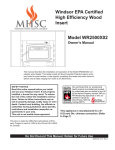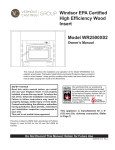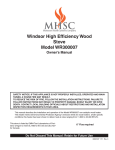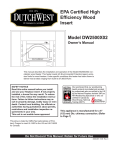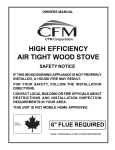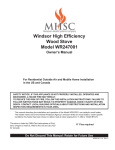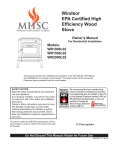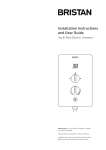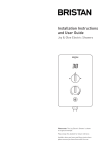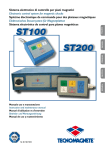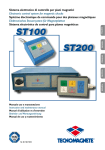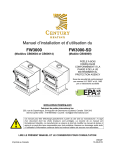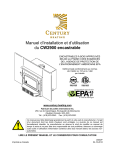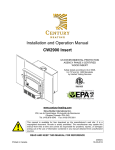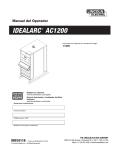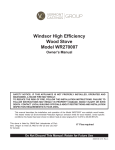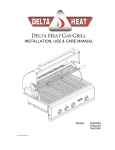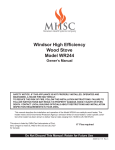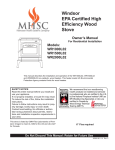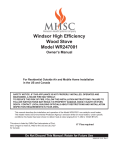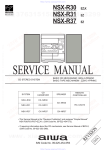Download MHSC WR2500X02 Owner`s manual
Transcript
Windsor EPA Certified High Efficiency Wood Insert Model WR2500X02 Owner’s Manual This manual describes the installation and operation of the Model WR2500X02 noncatalytic wood heater. This heater meets US Environmental Protection Agency emission limits for wood heaters. Under specific conditions this heater has been shown to 5129 deliver heat at rates ranging from 9,500 to 57,800 BTU/hr. WR2500X02 cover Safety notice Read this entire manual before you install and use your fireplace insert. If not properly installed, a house fire may result. To reduce the risk of fire, follow the installation instructions. Failure to follow instructions may result in property damage, bodily injury or even death. Contact local building, fire officials or authorities having jurisdiction about permits, restrictions and installation inspection requirements in your area. This unit is not mobile home approved. This appliance is manufactured for a 6” (152 mm) Dia. chimney connection. (Refer to Page 7) This stove is listed by OMNI-Test Laboratories of Portland, Oregon to meet UL1482 for the US and ULC-S628 for Canada. Do Not Discard This Manual: Retain for Future Use 30005129 3/10 Rev. 1 Windsor High Efficiency Wood Insert CAUTION After reading these instructions, if you have any doubt about your ability to complete your installation in a professional like manner you should obtain the services of an installer versed in all aspects as to the correct and safe installation. Do not use temporary makeshift compromises during installation. About Your Appliance 1. Hot while in operation. Keep children, clothing and furniture away. Contact may cause skin burns. 2. Do not burn garbage or flammable fluids. 3. Check with the building inspector’s office for compliance with local codes; a permit may be required. 4. This appliance requires installation in a masonry type fireplace only. DO NOT INSTALL IN A FACTORY BUILT FIREPLACE SUCH AS A ZERO CLEARANCE. 5. Always connect this unit to a chimney and NEVER vent to another room or inside a building. 6. Do not connect to any air distribution duct or system. 7. Do not connect this unit to a chimney flue serving another appliance. 8. A stainless steel chimney liner may be required. Check with local building, fire officials or authorities having jurisdiction in your area. 9. Do not use chemicals or fluids to start the fire. 10. The connector pipe and chimney should be inspected periodically and cleaned if necessary. 11. Remember the clearance distances when you place furniture or other objects within the area. DO NOT store wood, flammable liquids or other combustible materials too close to the unit. 12. Contact your local municipal or provincial fire authority for information on how to handle a chimney fire. Have a clearly understood plan to handle a chimney fire. In the event of a chimney fire, turn air control to closed position and CALL THE FIRE DEPARTMENT. 13. DO NOT tamper with air control beyond normal adjustment. 14. Once the required draw is obtained, operate only with doors closed and open door slowly when refueling. (This will reduce or eliminate smoke from entering the room). These units are not mobile home approved. Do not install this unit in a mobile home or trailer. Why the correct chimney size is important Your appliance operates best using a minimum 6” (152 mm) diameter chimney. The maximum chimney diameter must not exceed 10” (254 mm) in diameter or have a cross sectional area greater than 85 in2 (550 cm2). Today’s solid fuel appliances are much more efficient than in the past. The units are designed to give you controlled combustion, as well as maximum heat transfer, using less fuel to do so. The result of better heat transfer is lower chimney temperatures, making the chimney size important for good draft. Poor draft will create poor performance of your appliance, and a safety hazard. Should you experience a problem with smoke entering the room or poor combustion, call in a local chimney expert. Burn Rate With the door closed, the rate of burning is regulated by the amount of air allowed to enter the unit through the air control. With experience you will be able to set the control for the desired heat and burning time. Attempts to achieve higher output rates that exceed heater design specifications can result in permanent damage to the heater. The recommended wood load is level with the top of the firebricks. Overloading may prevent sufficient air entering the heater to properly fuel the fire. DO NOT tamper with air control beyond the normal adjustment capacity. WARNING: Operate this heater only with the door closed. ALWAYS PROVIDE A SOURCE OF FRESH AIR INTO THE ROOM WHERE THE UNIT IS INSTALLED. FAILURE TO DO SO MAY RESULT IN AIR STARVATION OF OTHER FUEL BURNING APPLIANCES AND THE POSSIBLE DEVELOPMENT OF HAZARDOUS CONDITIONS. THIS HEATER IS EXTREMELY HOT WHILE IN OPERATION. SERIOUS BURNS CAN RESULT FROM CONTACT. KEEP CHILDREN, CLOTHING AND FURNITURE AWAY. Proposition 65 Warning: Fuels used in gas, woodburning or oil fired appliances, and the products of combustion of such fuels, contain chemicals known to the State of California to cause cancer, birth defects and other reproductive harm. California Health & Safety Code Sec. 25249.6 30005129 Windsor High Efficiency Wood Insert Specifications Model WR2500X02 non-catalytic wood heater. This heater meets US Environmental Protection Agency’s emission limits for wood heaters. Under specific conditions this heater has been shown to deliver heat at rates ranging from 9,500 to 58,000 BTU per hour. Model WR2500X02 is listed by OMNI-Test Laboratories of Portland, OR and meets UL 1482 for the US and ULC S 627-00 for Canada. 266M” (679 mm) 206M” (527 mm) * 956M” (235 mm) 216M” (553 mm) 1656M” (413 mm) 31” (787 mm) 8(6” (225 mm) 44” (1118 mm) 10” (254 mm) 16” (406 mm) * Adjustable 10” (254 mm) to 14” (356 mm) Figure 1 WR2500X02 Dimensions 5129 NOTE: Refer to Pages 4 and 5 for clearancesWR2500X02 dims and floor protection information. 30005129 Windsor High Efficiency Wood Insert Installation Clearance to Combustible Constructions 1. Remove all boxes of firebricks and any packaging from inside the appliance. 2. Clean out the masonry fireplace ensuring the ashes are placed in a metal container. 3. Remove or lock open the damper plate in the masonry fireplace. 4. Contact local building, fire officials or authorities having jurisdiction about permits, restrictions and installation inspection requirements in your area. 5. The insert must be installed in compliance with the minimum clearances to combustible constructions and floor protection stated on appliance certifications label (located on back of unit) and listed below. Refer to Page 5 for further instructions about floor protection. FAILURE TO FOLLOW THESE MINIMUM CLEARANCES REQUIREMENTS MAY RESULT IN AN UNSAFE INSTALLATION. 6. Install the refractory bricks. (Fig. 3) 7. Install faceplate onto insert. (Page 7) The trim should fit against the face of the fireplace. If this is not a good fit, a 2” (51 mm) wide strip of fiberglass insulation can be used to insure a good fit. 12” (305 mm) Max Mantel Top Trim D B Side Trim Side Wall Face Plate C E Floor Floor Protector A F ST1022 Figure 2 Clearance to Combustibles Clearance to Combustible Constructions ST1022 A Unit to Side Wall 12” (305 mm) DW2500 clearances B Unit to Top Trim 10” (254 mm) 10/08 C Unit to Side Trim 10” (254 mm) D Unit to Mantel 17” (430 mm) E Floor Protector Front 16” (405 mm) in the US 18” (457 mm) in Canada F Floor Protector Side 8” (203 mm) Refer to Page 6 for Floor Protection requirements 30005129 Windsor High Efficiency Wood Insert 6 6 2 5 4 6 6 2 * 1 1 * 1 5 1 1 * 1 1 1 * ST1031 t Fr o n 3 3 1 2 Figure 3 Install Firebrick Tip - Install Front (*) Fire Bricks First Floor Protection This appliance must be installed in a masonry fireplace ST1031 enclosure built in accordance install firebrick with local building codes. DO 10/08 NOT INSTALL IN A FACTORY BUILT FIREPLACE SUCH AS A ZERO CLEARANCE. Floor protector must extend to cover area shown on the diagram below. When the floor covering the area shown is concrete, no floor protector is required. Carpeting and any other combustible material shall not cover the floor protector. ST1023 Face Plate 8” (203 mm) Figure 4 Floor Protector If a combustible surface is applied to the concrete floor, a clearance must be maintained equivalent to the area reserved for the floor protector. (Fig. 4) If the area shown is a combustible floor or a combustible floor covering, a 3/8” (10 mm) thick noncombustible millboard floor protector or durable equivalent must be installed. The pad must cover the area shown. A grouted ceramic floor tile surface installed per local building code is considered a durable equivalent. Door Side of Appliance 16” (406 mm) in the US 18” (457 mm) in Canada 8” (203 mm) Floor Protector Faceplate Assembly Refer to Figure 5 34 1. Assemble top (#1) to sides (#2) using #8 x 1/2” Tek FLOORPROTECTION screws (#9). 2. Attach the side right and left trims (#5,6) to sides (#2) using #8 brass screws. 3. Attach top right and left trims (#3,4) together with the articulating angles (#8). 4. Install corner brackets (#7) to top trim. 5. Attach top trim to face plate placing corner brackets into side trim and tightening screws in the corner brackets to secure. Face Plate Installation 1. Hook one end of spring (#10) into hole on stove top. 2. Hook the other end of the spring through the 1/8” (3 mm) hole in the faceplate top. (Fig. 6) 3. Slide the face plate against the masonry wall. NOTE: Use the installation bulletin supplied with the face plate as protection to prevent scratching the stove top. 30005129 Windsor High Efficiency Wood Insert 7 6” (152 mm) Min. Dia. Stainless Steel Flexible Liner 3 Figure 5 Face Plate Assembly 4 9 8 5 7 1 9 6 2 2 ST1026 Figure 7 Chimney Liner Masonry Fireplace 9 ST1024 End of Spring ST1024 faceplate assy 10/08 Face Plate Assembly Spring #10 Figure 6 Install Face Plate ST1025 Chimney 34 CONTACT YOUR LOCAL BUILDING AUTHORITY FACEPLATEINSTALL FOR APPROVED METHODS OF INSTALLATION. 1. A chimney connector shall not pass through an attic, roof space, closet, floor, ceiling or similar concealed space. Where passage through a wall or partition of combustible constructions is desired, the installation shall conform to CAN/CSA B365 (in Canada). In the US, check with local building officials for requirements in your area. 2. It is advisable to have your masonry chimney inspected for deterioration such as cracks and crumbling mortar before you install your unit. NOTES: A stainless steel adapter is recommended for fastening the stainless steel flexible liner to the collar. Male or crimped end of the adapter must be installed inside the flue collar. Drill flue collar to permanently fasten stainless steel adapter using a minimum of 3 screws. Fasten stainless steel chimney liner to the stainless steel adapter using manufactures instructions. 3. To help 34 ensure a good draft, the top of the chimney should be at least 3 feet (914 mm) above the point CHIMNEYLINER of penetration through the roof, and be at least 2 feet (610 mm) higher than any point of the roof within 10 feet (3 m). 4. Do not use makeshift compromises during installation. 5. Do not remove bricks or mortar from the fireplace. Canada: This fireplace insert must be installed with a continuous chimney liner of 6” (152 mm) minimum diameter extending form the flue collar to the top of the chimney. The chimney liner must conform to the class 3 requirements of CAN/ULC-S635 Standard for lining systems for existing masonry or factory-built chimneys and vents, or CAN/ULC-S640 Standard for lining systems for new masonry chimneys. (Fig. 7) USA: This fireplace insert must be connected to: 1. A chimney complying with the requirements for type HT chimneys in the Standard for Chimneys, Factorybuilt, Residential type and building Heating Appliance, UL103, or 2. A code-approved masonry chimney with flue liner. Alternate Chimney Installation Applies to USA ONLY Contact your local building authority for approved methods of installation. WARNING: This fireplace insert must be connected to: A chimney complying with the requirements for type HT chimneys in the Standard for Chimneys, Factorybuilt, Residential Type and building Heating Appliance, 30005129 Windsor High Efficiency Wood Insert Chimney Liner The cross-sectional area must not exceed 85 square inches (550 cm2) Chimney Connector into the first section of the flue liner The smoke chamber must be sealed using noncombustible material, to prevent smoke from re-entering the room. The installation must allow the chimney system to be inspected and cleaned. Masonry Fireplace Drill flue collar to permanently fasten chimney connector. A minimum of 3 screws will be required. Insert 5. Do not use makeshift compromises during installation. 6. Do not remove bricks or mortar from the fireplace. EXCEPTION (5) Page 7: Masonry or steel, including the damper plate, may be removed from the smoke shelf and adjacent damper frame if necessary to accommodate a chimney liner, provided that their removal will not weaken the structure of the fireplace and chimney, and will not reduce protection for combustible materials to less than required by the National Building Code. Consult with local building authorities having jurisdiction before starting. IMPORTANT: Warning Label Installation A metal warning tag has been included with your fireplace insert. This tag is to be securely installed in a visible location on your fireplace so that it is known the fireplace has possibly been modified to accept the insert. ST1027 Figure 8 Alternate Chimney Installation UL103 OR A code-approved masonry chimney with 34 chimney liner. 53CHIMNEYLINER 1. This insert must be connected to a code-approved masonry chimney or listed factory-built fireplace chimney. When installation is to a factory-built fireplace chimney, a direct flue connection will be required. Contact the chimney manufacturer or local building authorities for approved method. When installation is into a masonry chimney, a chimney connector of a minimum 24 gauge steel must be installed into the first chimney liner section. The cross sectional area of the either type of chimney must not be less than the inside cross sectional area of the flue collar, nor shall it be greater than 85 square inches (550 cm2). The chimney connector must be secured with a minimum 3 screws at the flue collar and each adjoining sections. 2. A chimney connector shall not pass through an attic, roof space, closet, floor, ceiling or similar concealed space. Where passage through a wall or partition of combustible construction is desired, check with local building officials for requirements in your area. 3. It is advisable to have your masonry chimney inspected for deterioration such as cracks and crumbling mortar before you install your unit. 4. To help ensure a good draft, the top of the chimney should be at least 3 feet (914 mm) above the point of penetration through the roof, and be at least 2 feet (619 m) higher than any point of the roof within 10 feet (3 m). 30005129 Metal Tag ST1028 Figure 9 Place Metal Tag on Masonry Fireplace 34 METALTAG Blower Installation 1. Remove screws from insert body, route cord under body and through the cut out. Attach the blower with the screws previously removed. (Fig. 10) Blower unit should be removed occasionally, inspected and cleaned. BE SURE TO DISCONNECT POWER SUPPLY BEFORE SERVICING BLOWER. 2. DO NOT REMOVE INSULATING MATERIAL FROM FIRE BOX. 3. Install handle holder on left side of insert using blower mounting screw. (Fig. 11) Windsor High Efficiency Wood Insert Operation Do not use a grate or elevate fire. Build wood fire directly on hearth. When the stove is used for the first time the solvents in the paint will smoke off. Face Plate Wood This heater is designed to burn natural wood only. Higher efficiency and lower emissions generally result when burning air dried seasoned hardwood, as compared to softwood or to green or freshly cut hardwood. Insert O PE N ST1029 CL O SE Air Control spring Handle 3-Prong Grounded Plug use 110V A, 15 Amp Supply Power Handle Holder Blower Assembly Fan Mounting Screw (2) Figure 1034 Blower Installation BLOWERINSTALL Handle ST1030 Blower Mounting Screw Figure 11 Install Handle Holder Handle Holder Only use dry seasoned wood. Green wood, besides burning at only 60 percent of the fuel value of dry wood, deposits creosote on the inside of your stove and along the chimney. This can cause an extreme danger of chimney fire. To be called “seasoned”, wood must be dried for a year. Regardless of whether the wood is green or seasoned, it should be stored in a well-sheltered, ventilated area to allow proper drying during the year to come. Wood should be stored beyond recommended clearance from combustibles. DO NOT BURN: Treated Wood Solvents Trash Coal Garbage Cardboard Colored Paper Instructions for First Burn - Curing the Stove Paint Your stove has been painted with the highest quality stove paint and has special break-in procedures. The heat generated by the normal operation of the stove, will serve to harden the paint. Ventilate the house during the first three times the stove is used. The paint on the stove will give off smoke, carbon dioxide and an odor. Without adequate ventilation, concentrations of smoke could irritate you or cause damage to person and/or property. Open doors and windows and use a fan if necessary. After the initial burns the paint will be cured and there should be no more smoke. Each of the initial burns should be conducted as follows: 1. The first and second burns should be approximately 250° F (120° C) for approximately 20 minutes. 2. The third burn should be between 500° F (260 to 370° C) for at least 45 minutes. The important fact is the paint should be cured slowly. Avoid hot fires during the curing process. During the curing process the paint will be gummy. Once cured the paint will remain hard. 34 HANDLEHOLDER 30005129 Windsor High Efficiency Wood Insert It is normal to see flat spots on painted surfaces of the stove. The flat spots on the paint surface indicate the hotter surfaces of the stove, and is caused by the heat radiating through the paint. It is also expected that shiny spots caused by friction from the packaging materials, will disappear during the curing of the stove. SO: 1. Remember to ventilate well. 2. Allow the stove to cure before burning for long periods at high temperatures. 3. Flat spots on the painted surfaces are normal. 4. Shiny spots on the paint surface before burning is normal. 5. Call your dealer if you have any questions. Building a Fire Never use gasoline, gasoline-type lantern fuel, kerosene, charcoal lighter fluid or similar liquids to start or ‘freshen up’ a fire in this heater. Keep all such liquids well away from the heater while it is in use. 1. Open inlet air control fully. 2. Place a small amount of crumpled paper in the stove. 3. Cover the paper with a generous amount of kindling in a teepee fashion and a few small pieces of wood. 4. Ignite the paper and close door. If fire dies down substantially, open door slightly. 5. Add larger pieces of wood as the fire progresses being careful not to overload. Do not fill firebox beyond firebrick area. An ideal coal bed of 1” to 2” should be established to achieve optimum performance. 6. This unit is designed to function most effectively when air is allowed to circulate to all areas of the firebox. An ideal means of achieving this is to rake a slight (1” to 2” wide) trough in the center of the coal bed from front to back prior to loading the fuel. 7. Once fuel has been loaded, close the door and open air inlet control fully until fire is well established (approx. 10 minutes) being careful not to overfire. 8. Readjust air inlet control to desired burn rate. If excessive smoke fills firebox, open air inlet control slightly until flames resume and wood is sufficiently ignited. While a basic rule of thumb is “closed-low”, “1/2 way - medium” and “fully open-high”, refer to the Inlet Air Control Settings chart. 9. When refueling, adjust air control to the fully open position. When fire brightens, slowly and carefully open the door. This procedure will prevent gases from igniting causing smoke and flame spillage. 10.Add fuel being careful not to overload. 30005129 Desired Burn Setting Low Med / High High Inlet Air Control Settings Inlet **Approx. Air Setting BTU Output Fully Closed 9,500 1/2” (13 mm) Open 16,315 Fully Open 58,000 Glass Care The following use and safety tips should be observed. 1. Inspect the glass regularly for cracks and breaks. If you detect a crack or break, extinguish the fire immediately and contact your dealer for replacement. 2. Do not slam door or otherwise impact the glass. When closing doors, make sure that logs or other objects do not protrude and impact the glass. 3. Do not clean the glass with materials which may scratch (or otherwise damage) the glass. Scratches on the glass can develop into cracks or breaks. 4. Never attempt to clean the glass while unit is hot. If the deposit is not very heavy, normal glass cleaners are adequate with a plain, nonabrasive scouring pad. Heavier deposits may be removed with the use of a readily available oven cleaner. 5. Never put substances which can ignite explosively in the unit since even small explosions in confined areas can blow out the glass. 6. This unit has an airwash system, designed to reduce deposits on glass. Replace glass only with high temperature Robax Pyroceram of the proper size and thickness. Gasket Replacement After extensive use, the sealing material which provides glass and door seal may need to be replaced if it fails to sustain its resilience. Inspect glass and door seal periodically to ensure for proper seal. If gaskets become frayed or worn, replace immediately. Contact your dealer for approved replacement parts. The following steps should be followed for glass gasket replacement: 1. Ensure appliance is not in operation and has thoroughly cooled. 2. Remove screw and glass clip. 3. Lift glass out from glass clip. 4. Remove old gasket and clean glass. 5. Replace new gasket starting at the bottom of glass working along edges, being sure to center gasket channel on glass. 6. Trim to length and butt ends together. 7. Replace glass in door, being sure not to over-tighten screw and clip. Windsor High Efficiency Wood Insert The following steps should be followed for door gasket replacement: 1. Ensure appliance is not in operation and has thoroughly cooled. 2. Remove old door gasket and clean channel. 3. Using an approved high temperature gasket cement, apply a thin coat in bottom of channel. 4. Starting at hinge side of door, work into around door unit, and butt and trim to length. 5. Close door and allow three to four hours for cement to set before restarting appliance. Creosote When wood is burned slowly, it produces tar and other organic vapors. These combine with moisture to form creosote. Creosote vapors condense in the relatively cool chimney flue of a slow-burning fire. As a result, creosote residue accumulates on the flue lining. When ignited, this creosote makes an extremely hot fire. The chimney should be inspected regularly during the heating season to determine if a creosote build-up has accumulated. If this is the case, the creosote should be removed to reduce the risk of chimney fire. Ways to Prevent and Keep Unit Free of Creosote 1. Burn with air control open for several minutes at numerous intervals throughout the day during the heating season, being careful not to over-fire unit. This removes the slight film of creosote accumulated during low burn periods. 2. Burn stove with draft control wide open for several minutes every time you apply fresh wood. This allows wood to achieve the charcoal stage faster and burns wood vapors which might otherwise be deposited within the system. 3. Burn only seasoned wood. Avoid burning wet or green wood. Seasoned wood has been dried for at least one year. 4. A small hot fire is preferable to a large smouldering one that can deposit creosote within the system. 5. Establish a routine for the fuel, wood burner and firing technique. Check daily for creosote build-up until experience shows how often you need to clean to be safe. Be aware that the hotter the fire, the less creosote is deposited. Weekly cleaning may be necessary in mild weather even though monthly cleaning may be enough in the coldest months. Contact your local municipal authority for information on how to handle a chimney fire. Have a clearly understood plan to handle a chimney fire. 10 WARNING: Things to remember in case of chimney fire: 1. Close draft control. 2. Call the fire department. Ash Disposal During constant use, ashes should be removed every few days, or whenever ashes get to three to four inches deep in the firebox. Remove ashes only when the fire has died down and the ashes have cooled. Even then, expect to find a few hot embers. Ashes should be placed in a metal container with a tight-fitting lid. The closed container of ashes should be placed on a noncombustible floor, well away from all combustible materials, pending final disposal. If the ashes are disposed of by burial in soil or otherwise locally dispersed, they should be retained in the closed container until all cinders have thoroughly cooled. Other waste should not be placed in the ash can. Inspection of the Insert Inspection of the insert can be accomplished with the removal of the face plate only. Once the face plate has been removed, there should be enough space to inspect the insert with the aid of a flash light. To remove face plate, follow face plate installation instructions on Page 7. IMPORTANT Helpful Hints 1. What is the correct way to start a fire? a. You will need small pieces of dry wood (kindling) and paper. Use only newspaper or paper that has not been coated or had unknown materials glued or applied to it. Never use coated (typically advertising flyers) or colored paper. b. Open the door of the wood stove. c. Crumple several pieces of paper and place them in the center of the firebox and directly on to the firebricks of the wood stove. Never use a grate to elevate the fire. d. Place small pieces of dry wood kindling) over the paper in a teepee manner. This allows for good air circulation, which is critical for good combustion. e. Light the crumpled paper in 2 or 3 locations: NOTE: It is important to heat the air in the stovepipe for draft to start. f. Fully open the air control of the wood stove and close the door until it is slightly open, allowing for much needed air to be introduced into the fire box. Never leave the door fully open as sparks from the kindling may occur causing injury or property damage. As the fire begins to burn the 30005129 Windsor High Efficiency Wood Insert kindling, some additional kindling may be needed to sustain the fire. DO NOT add more paper after the fire has started. g. Once the kindling has started to burn, add some of the smaller pieces of seasoned (dry) firewood. NOTE: Adding large pieces at the early stages will only serve to smother the fire. Continue adding small pieces of seasoned (dry) firewood, keeping the door slightly open until each piece starts to ignite. Remember to always open the door slowly when placing wood into the fire. h. Once the wood has started to ignite and the smoke has reduced, close the wood stove door fully. The reduction of smoke is a good indication that the draft in the chimney has started and good combustion is now possible. Larger pieces of seasoned (dry) firewood can now be added when there is sufficient space in the firebox. Adjust the air control setting to desired setting. i. NOTE: The lower the air control setting the longer the burn time of your firewood. 2. What type of wood is best to use as firewood? Dry seasoned hardwood should be used. Avoid green unseasoned wood. Green wood, besides burning at only 60 percent of the fuel value of dry seasoned wood, will deposit creosote on the inside of your stove and along the inside of your chimney. 3. What does dry seasoned wood mean, and what is considered hardwood? Wood that has been dried for a period of one year in a well-ventilated and sheltered area would be considered dry seasoned wood. Hardwoods are generally from slow growth trees (Example: Oak and fir) Softwoods are generally from fast growth trees. (Example: Pine and spruce). 4. Will following the above listed steps for starting a fire result in perfect results all the time? The quick answer is most of the time. There are many variables that may affect your success rate when starting a fire. Most of those variables and how to deal with them will be learned through experience. Your ability to start a good fire will significantly increase with time and patience. Some of the reasons for poor stove performance will be covered next. 30005129 5. Why can’t I get the fire lit? Damp or wet wood and poor draft are the main reasons for poor results in starting a fire. Always use dry seasoned wood for your fire. Even wood dried for two years will be difficult to ignite, if it has become wet. 6. Why is there always a large quantity of thick black smoke present in the firebox? A large quantity of thick black smoke in the firebox, is a good indication that the draft is poor. 7. Is it normal for soot to cover the glass at the beginning of a fire? Your stove has been built with an air wash system that will help keep the glass clear when the firebox has reached a good operating temperature and has a good draft. Cold firebox temperature and poor draft cause sooting of the glass. Once the firebox temperature and the draft increases, the soot will burn off. 8. What is draft? Draft is the ability of the chimney to exhaust draw by-products produced during the normal combustion process. 9. What can cause a poor draft? The most common factors for poor draft are: a. Atmospheric pressure and air supply b. Environmental conditions c. Cold chimney temperature d. Poor chimney installation and maintenance a. Atmospheric Pressure and Air Supply Atmospheric pressure affecting the draft from a chimney can be either outside the home, inside the home or both. Outside the home, a high-pressure day (clear and cool) generally creates a better draft in the chimney than a low-pressure day (overcast and damp). Inside the home, normal household appliances, such as clothes dryers and forced air furnaces compete for air resulting in inadequate amounts of air available to fuel a fire and create a condition known as negative pressure. Under extreme conditions of negative pressure the combustion by-products can be drawn from the chimney and into the house. 11 Windsor High Efficiency Wood Insert This condition is commonly referred to as down drafting. There are several factors that impact the amount of air available in the home. Increased amounts of insulation vinyl windows, extra caulking in various places and door seals can all keep heat in but may also make a home too airtight. If you are in doubt about whether or not there is sufficient air in your home for your stove, curtail using those appliances known to consume the air where possible, or open a window or door to allow air to enter the home. b. Environmental Conditions High trees, low lying house location such as in a valley, tall buildings or structures surrounding your house and windy conditions can cause poor draft or down drafting. c. Cold Chimney Temperature Avoid cold chimney temperatures by burning a hot fire for the first fifteen to forty minutes, being careful not to over fire. If any part of the chimney or parts of the stove start to glow, you are over firing the stove. Where possible, install a temperature gauge on the chimney so temperature drops can be seen. 12 d. Chimney Installation and Maintenance Avoid using too many elbows or long horizontal runs. If in doubt, contact a chimney expert and/or chimney manufacturer for help. Clean chimney, rain caps and especially spark arrester regularly, to prevent creosote build up, which will significantly reduce chimney draw and may cause a chimney fire. 10.Should I close or open the air control fully when shutting down the stove? When shutting down the stove, fully open the air control. This allows the chimney temperatures to remain as high as possible for as long as possible. Cold chimney temperatures create creosote. NOTE: this sheet is intended as an aid and does not supersede any local, provincial or state requirements. Check with officials or authorities having jurisdiction in your area. 30005129 Windsor High Efficiency Wood Insert 15 8 1 6 7 13 5 16 9 10 17 14 30 34 2 3 26 11 35 31 28 27 33 12 4 34 30 24 23 31 25 29 25 19 22 23 21 23 18 23 18 19 22 18 18 18 18 18 18 32 20 MHSC reserves the right to make changes in design, materials, specifications, prices and discontinue colors and products at any time, without notice. 5129 WR2500x2 parts WR2500X02 Wood Insert Item No. 1. 2. 3. 4. 5. 6. 7. 8. 9. 10. 11. 12. 13. 14. 30005129 Description Door Casting - Black Glass and Gasket 1/8” (3 mm) Glass Gasket 5/8” (16 mm) Door Gasket Pawl Assembly Handle - Black, Wood Insert Lifter Handle - Nickel Screw - 1/4-20 x 3 Handle Assembly Lock Nut Glass Clips Screw #10 x 1/2 Hinge Pin 3/8 Retaining Ring Qty. 1 1 4.6’ 5.2’ 1 1 1 1 1 1 7 7 2 2 Part No. S12071 S31141 S15001 S15011 30002362 1600664 1600650 1201310 5004245 1203290 S37034 S11086 S11005 S11090 13 Windsor High Efficiency Wood Insert WR2500X02 Wood Insert (continued) 14 Item No. 15. 16. 17. 18. 19. 20. 21. 22. 23. 24. 25. 26. 27. 28. 29. 30. 31. 32. 33. 34. 35. Description Baffle Assembly Secondary Air Tube Cotter Pin Firebrick 4M\zn” (113 mm) x 9” (229 mm) x 1Z\v” (32 mm) Firebrick 4M\zn” (113 mm) x 7Z\v” 184 mm) x 1Z\v” (32 mm) Firebrick 4M\zn” (113 mm) x 4Z\x” (114 mm) x 1Z\v” (32 mm) Firebrick 2Z\v” (57 mm) x 8” (203 mm) x 1Z\v” (32 mm) Firebrick - Angled Firebrick 4M\zn” (113 mm) x 8” (203 mm) x 1Z\v” (32 mm) Faceplate - Top Faceplate - Side Trim - Top Right Trim - Top Left Trim - Side Right Trim - Side Left Corner - 90° #8 Screw Spring Articulated Angle Back plate, Trim Corner Back plate, Articulated Angle Qty. 1 3 3 9 2 1 1 2 4 1 2 1 1 1 1 2 6 2 1 2 2 Part No. S41467 S32711 S11421 S16040 S16043 S16046 S16271 S16013 S16138 S38050 S38051 90000072 90000071 90000076 90000075 S11092 50960 S11403 S11127 30004606 30004607 30005129 Limited Lifetime Warranty Windsor High Efficiency Wood Insert Limited Three Year Warranty MHSC (hereafter referred to as the “company”) warrants that your new Windsor brand wood burning plate steel stove or masonry wood insert is free from manufacturing and material defects for a period of three years from the date of sale, subject to the following conditions and limitations. Limited One Year Warranty Electrical components such as blowers and speed controls are covered for one year only. Glass door panels are covered for thermal breakage only. To clean glass, use a ceramic glass cleaner or polish. Do not use ammonia-based cleaners. A suitable cleaner is available from your nearest Hearth Products dealer. DO NOT CLEAN GLASS WHILE HOT AND DO NOT USE ABRASIVE CLEANERS. Excluded from Warranty Brass parts should be cleaned with soap and warm water and immediately dried. Brass parts may also be damaged by external chemicals. Gold and any other plated parts will not be covered under this warranty. Plated surfaces should be cleaned by using denatured alcohol only and rubbed lightly with a lint-free nonabrasive cloth. Excessive rubbing or polishing may remove the plated finish. Discoloration of certain parts is normal and is not a defect, and therefore not covered under warranty. This warranty will not include or extend to paint, gaskets, baffles or firebrick components, and does not cover any removable firebox components such as brick retainers or stainless steel air tubes. Extended Limited Lifetime Warranty The company offers a limited lifetime warranty on the firebox (welds only), castings and ash drawers on any of Windsor wood burning products. The limited lifetime warranty is extended to the original owner only, and is subject to proof of purchase by the original owner and residential use. 1. The new Windsor product must be installed and operated at all times in accordance with the installation and operation instructions supplied with the appliance, and installation must be to local and national codes. Any alterations, willful abuse, accident, over firing or misuse will not be covered under warranty. NOTE: Some minor movement of certain parts is normal and is not a defect and therefore, not covered under warranty. 2. The warranty is non-transferable, and is made to the original owner, provided that the purchase was made through an authorized MHSC supplier. The serial number must be supplied along with the Bill of Sale, showing the date of purchase, at the time the claim is submitted. 3. This warranty is limited to the repair or replacement of parts only and is applicable only to those parts found to be defective in material or construction that have been subjected to normal conditions of use and service. All defects must be confirmed by the company or an authorized representative. If requested by the company, defective parts must be shipped back transportation prepaid, to the company. Credits will be issued upon receipt of return of the defective product to the company. 4. The company, at its discretion, can fully discharge all obligation with respect to this warranty by refunding the wholesale price of the defective part(s). 5. Any installation, labor, construction, transportation or other related costs or expenses arising from defective parts, repair, replacement or otherwise of same, will not be covered by this warranty, nor will the company assume responsibility for same. Further, the company will not be responsible for any incidental, indirect or consequent damages, except as provided by law, and in no event shall they exceed the original purchase price. 6. All other warranties - expressed or implied - with respect to the product, its components and accessories, or any obligations /liabilities on the part of the company are hereby expressly excluded. 7. MHSC neither assumes, nor authorizes any third party to assume, on MHSC’s behalf, any other liabilities with respect to the sale of this MHSC product. 8. The warranties as outlined within this document do not apply to chimney components or other products made by other manufacturers when used in conjunction with the installation of this product. Improper use or the use of non-approved components may nullify your warranty. If in doubt, contact your nearest authorized MHSC supplier or MHSC Customer Service Department. 9. MHSC will not be responsible for: • Down drafts or spillage caused by environmental conditions such as near-by trees, buildings, rooftops, hills, mountains or ineffective chimney design. • Inadequate ventilation, excessive offsets or negative air pressure caused by mechanical systems such as furnaces, clothes dryers, fans, etc. 10.This warranty is void if: • The appliance has been operated in atmospheres contaminated by chlorine, fluorine, or other damaging chemicals. • This appliance has been subjected to prolonged periods of dampness or condensation. • The appliance has any damage due to water, or weather damage that is the result of, but not limited to, improper chimney/venting installation. • The appliance has been subjected to willful or accidental abuse or misuse. • Corrosive driftwood, manufactured logs or other fuels are used other than as outlined in the installation and operating instructions. • The appliance is not maintained in good condition, including firebrick and gaskets. IF WARRANTY SERVICE IS REQUIRED Contact MHSC Customer Service. Make sure you have your sales receipt and the model/serial number of your MHSC product. Do not attempt to do any service work yourself, unless pre-approved by MHSC in writing this will void the warranty. MHSC must authorize service and provide a Warranty Claim Number prior to any warranty related service calls. Without an authorization number, any service work will not be deemed warranty. NOTE: Some states and provinces do not allow the exclusion or limitation of incidental or consequential damages. The above limitation may not apply to you. MHSC 149 Cleveland Drive Paris, KY 40361 KEEP THIS WARRANTY Serial # _______________________________ Model # ______________________________ Date Purchased ________________________ 30005129 15 MHSC 149 Cleveland Drive • Paris, Kentucky 40361 www.mhsc.com
















